While there was some modest compression in the famous "jaws" chart last week, the market's biggest paradox of 2019 continues to vex traders, investors and even algos. Namely that, as Deutsche Bank's Parag Thatte writes, bond yields are in line with slowing growth, while equities are priced for a strong rebound, a theme discussed extensively last month in "How Can The Economy Both Be Booming And Headed For A Recession: A Quantum Explanation.")
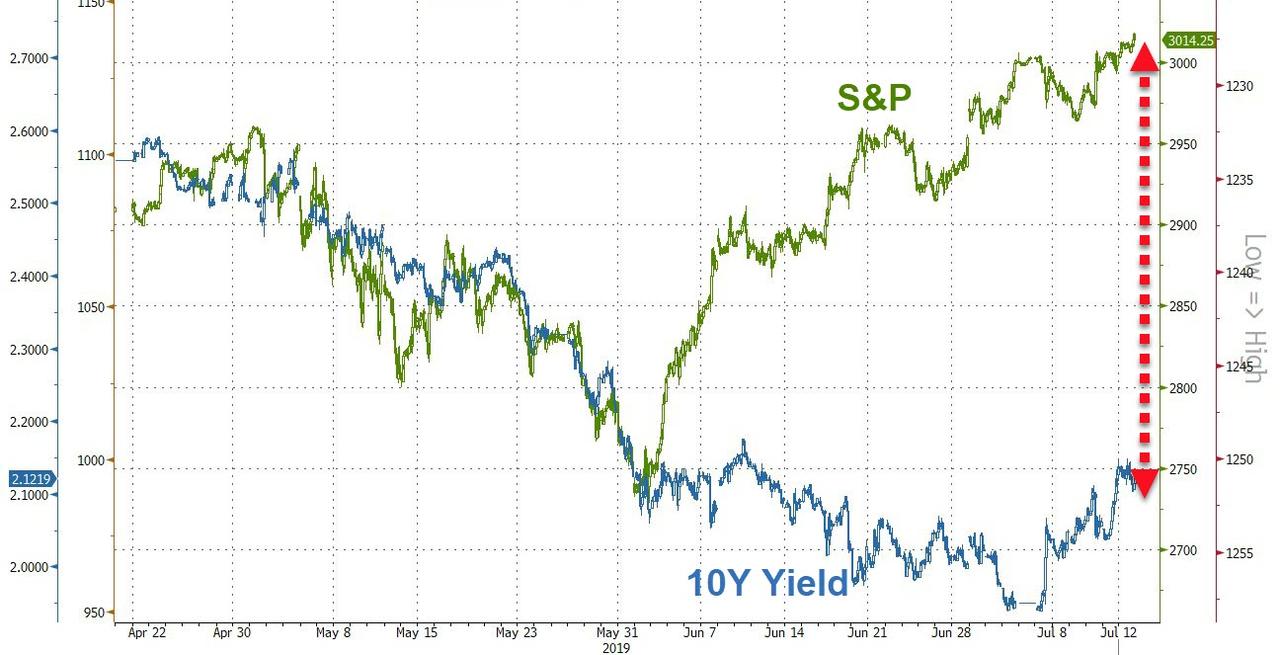
If looking purely at the fundamentals, bond yields have tracked growth indicators like the ISM Manufacturing index closely through this cycle and have declined in line with slowing growth.
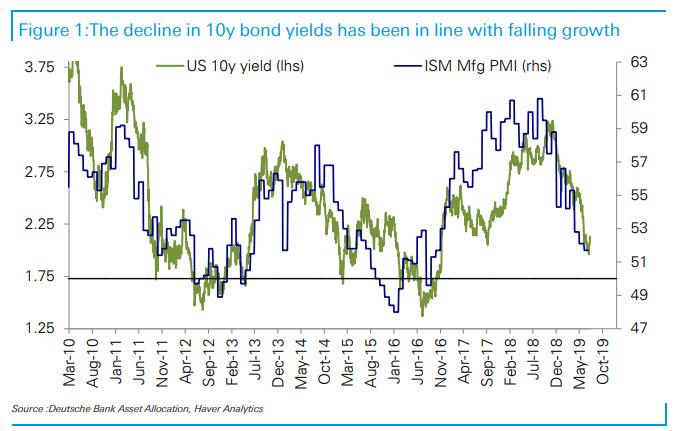
Equities, on the other hand, are pricing in a significant rebound in the ISM from under 52 currently back up to around 57.
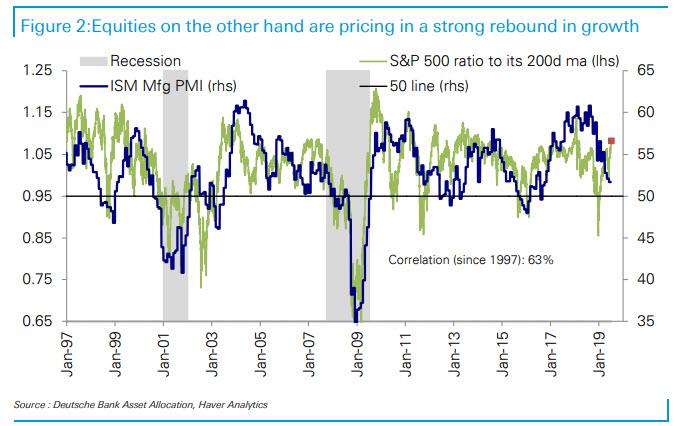
The technicals are familiar as well: the bond rally has been underpinned by near-record inflows and long positioning. Specifically, global bond funds have seen inflows of almost $330bn, close to the largest over comparable periods historically. Inflows are, in fact, at levels from which they have typically slowed in the past according to DB.
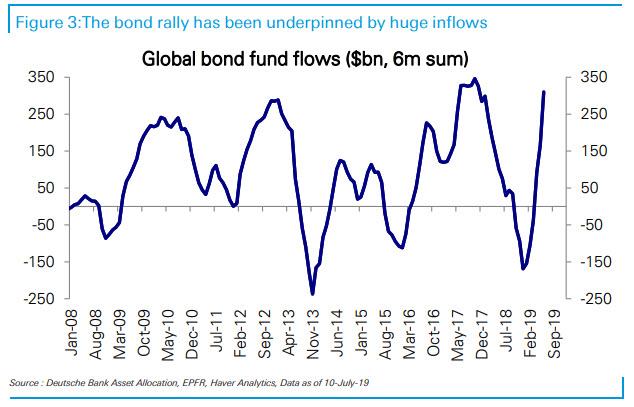
Meanwhile, and more importantly, as we first noted back on June 9, positioning in Eurodollar rates futures has continued to climb over the last year and is now well beyond levels seen around the mini-rate cutting cycles of 1995 and 1998 and similar to levels seen during the European financial crisis and the Great Financial Crisis in 2007-2009. Long rates-positioning typically does not start to unwind until the Fed is done easing.
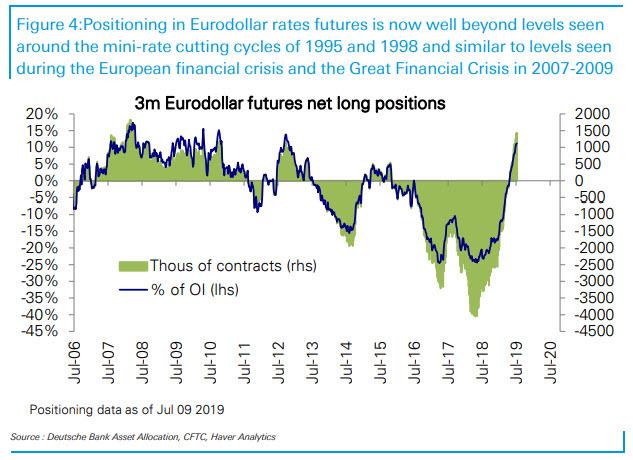
And according to the following breakdown of investor positioning in cross-asset futures, the stampede to get long EDs is now the most powerful force in the entire market, as the market is now convinced the Fed has capitulated to... the market.
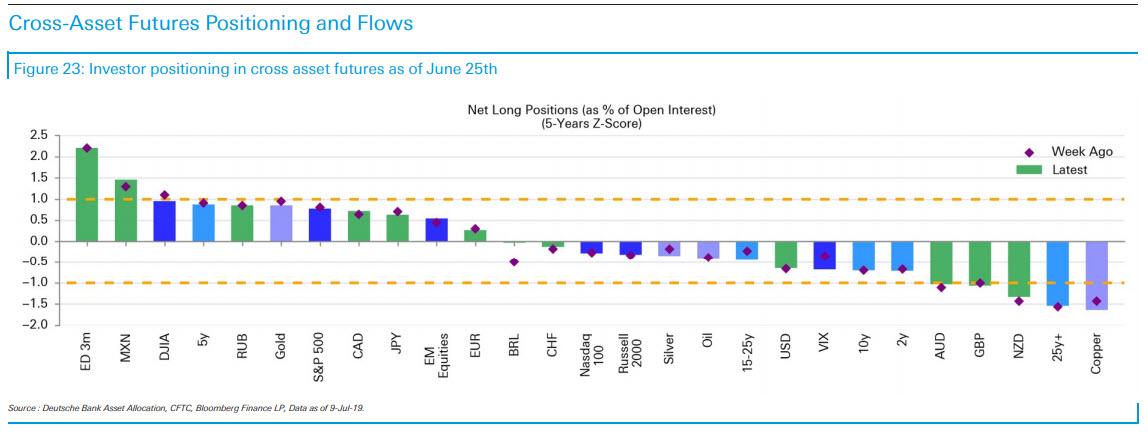
Which brings us back to the most important question of 2019: What's driving the equity rally?
According to Deutsche Bank, despite the confusion, the rally has been in line with what the bank's demand-supply framework has predicted: large sustained buybacks and rising systematic strategies positioning have offset fund outflows, even as risks are rising on the horizon.
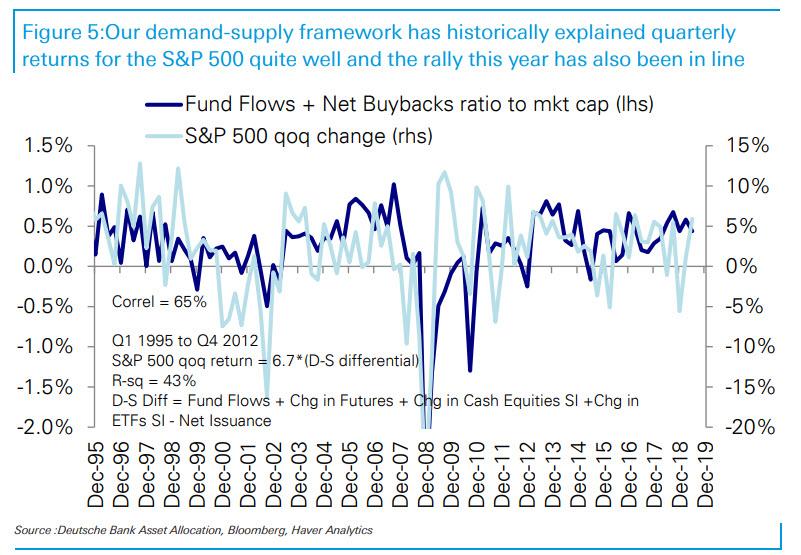
Here is Thatte's explanation:
Our simple framework combining, on the demand side, inflows into equities (mutual funds and ETFs) and changes in positioning with, on the supply side, new issuance and buybacks, has historically explained quarterly returns for the S&P 500 quite well, and the rally has not been out of line with our estimate of the demand-supply balance.
The first component of the stock "demand" equation - buybacks - has been extensively discussed for much of the past decade on this website and elsewhere, and has now become a controversial political point; more importantly, Thatte asserts that buybacks are likely to sustain at elevated levels outside of a large decline in earnings. Furthermore, as regular readers know very well, from a demand-supply perspective, buybacks have been the most important driver of S&P 500 price increases during this cycle.
They have been running at over $200bn a quarter (gross) over the last year. While announcements remain noisy, they do not suggest a slowing yet. The level of corporate earnings is the primary driver of buybacks. Earnings have been flat this year and are on track to be down slightly in Q2. But absent a large decline, companies are likely to maintain the pace of buybacks, as they did in the previous earnings slowdowns in 2011-2012 and 2015-2016. And while concerns around leverage continue to fester, it is worth recalling that for now at least, the bulk of buybacks are carried out by companies with very low, not high, leverage, especially the tech sector most recently.
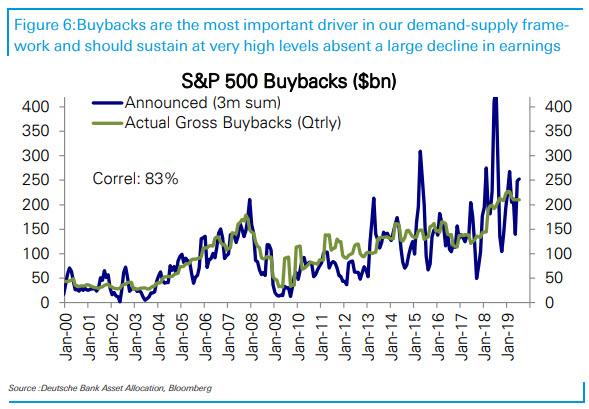
At the same time, after record months of outflows since December, equities have seen modest inflows since June but weak growth and data remain a risk, according to DB. After outflows of over $240bn since December, equity funds have seen a respite over the last 5 weeks with modest inflows (average $1bn per week). Still, the inflows have been primarily into US and Japanese funds, while Europe and EM continue to bleed. The recent inflows have occurred despite weakening data surprises and remain vulnerable to a continued growth slowdown
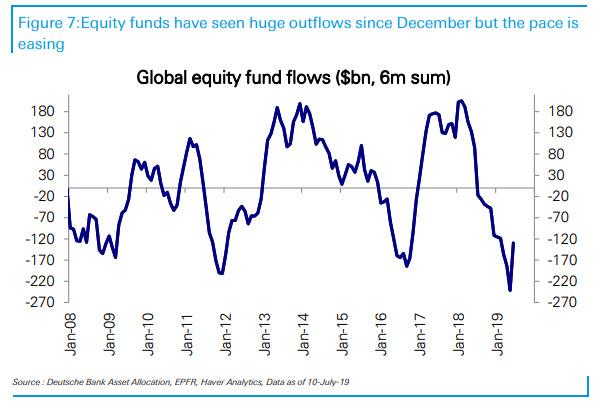
Third on the list of key technical factors, investor positioning remains elevated, especially for systematic strategies. Equity futures long positions, combining asset managers and leveraged funds, are at the top of their historical range while other near-term indicators like the put/call volume ratio also point to bullish equity positioning. Meanwhile, across systematic strategies, exposures are very elevated across the board, and risk remains asymmetric to the downside.
Vol control is already at max equity allocations and have little room to buy even if vol were to decline further while they would quickly turn to selling equities if vol spikes.
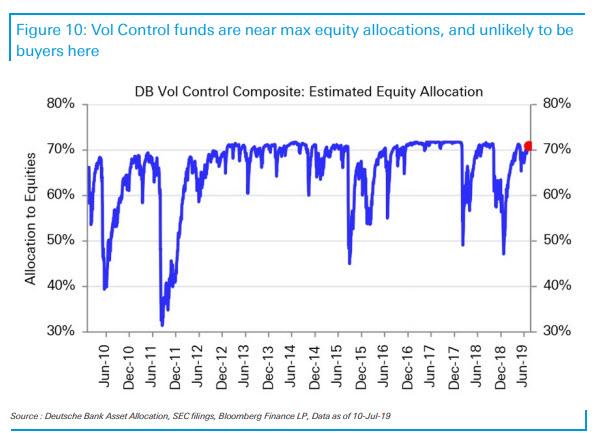
CTAs and risk parity funds have continued to add to equity allocations which are high but not as much as in early 2018.
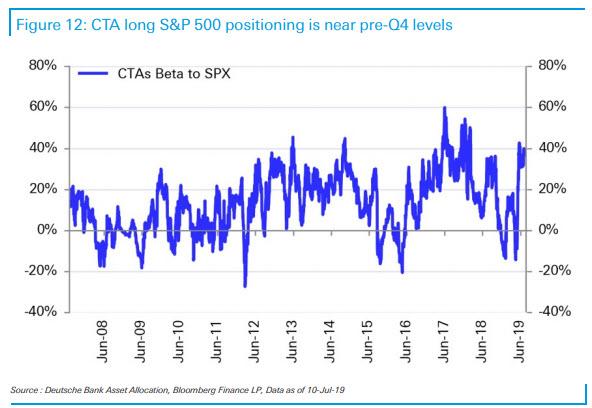
Recent negative correlation between bonds and equities has aided in the low volatility of cross asset portfolio.
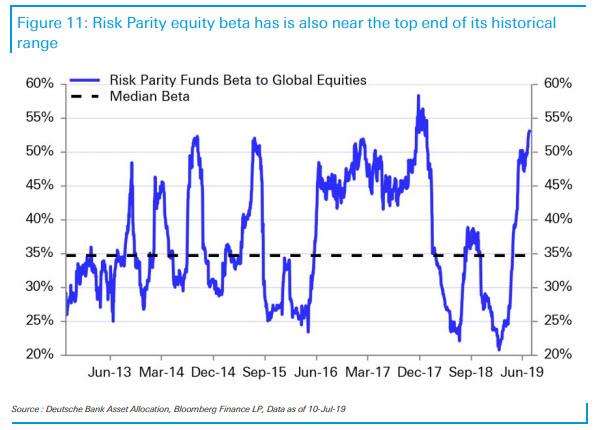
Given that these managers are relatively slow moving, markets would need a sustained vol event for significant de-allocations. Net beta for long-short equity funds, however, remains very low, while retail positioning indicators also remain subdued.
Finally, according to the latest CFTC breakdown of spec accounts, net positioning in US equity futures fell for the second week but remains near the top of its historical range. Positioning across most US indices fell except for the NASDAQ which saw long positioning inch higher and Russell 2000 which saw short positioning fall slightly.
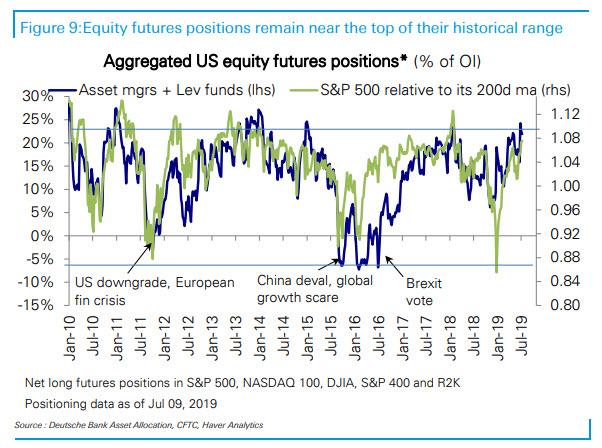
Finally, as JPMorgan summarizes, "as the Q2 reporting season begins, corporate profits growth and Equity/Credit performance versus Bonds have come to an important crossroads. Multi-asset investors and many other readers know the following:
- US earnings growth and margins peaked in late 2018 and have been slowing since, in line with the deceleration in global activity
- consensus expectations anticipate Q2 EPS growth of -2% year-on-year, which would mark the first such contraction since the 2015-16 earnings recessions that persisted for four quarters;
- the balance of earnings pre-announcements has been the most negative since that 2015-16 earnings recession (70% negative, 19% positive, so -51% net); but
- Investor positioning is mixed, with Equity Long/Short hedge funds holding well below-average exposure but Macro, Systematic and Risk Parity funds holding above-average exposure. ETF flows mirror the conservatism of Long/Short funds, with net purchases favoring Defensives over Cyclicals this year.
And yet, even as equity Long/Short funds hold below-average exposure to stocks but Macro, Systematic and Risk Parity funds hold above-average longs.
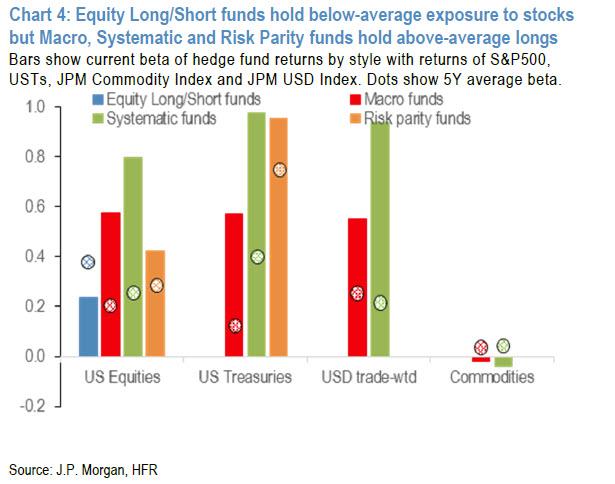
In other words, the one catalyst that will push stocks higher this earnings season will be earnings "wall of worry", with consensus now expecting a -2% drop, while the final print, somewhere just around +1 to +2% (all on a non-GAAP, adjusted basis) will be sufficient to send the S&P to 3,200 or so... just as the Fed cuts rates by as much as 50bps at the end of the month.
Commenti
Posta un commento